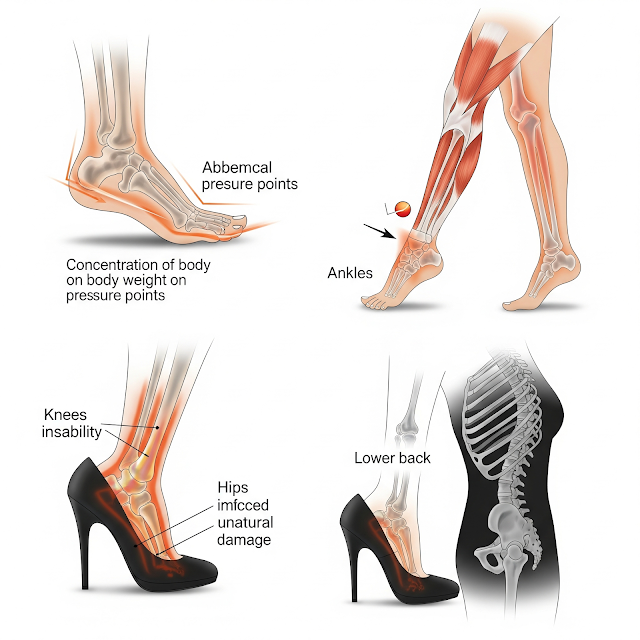Table of Contents
1. The Importance of Shoe Choices
The shoes we wear daily are more than just fashion items; they significantly impact our lower body health. Poor shoe choices can lead to various problems not only in the feet but also in the ankles, knees, hips, and lower back. Therefore, choosing shoes carefully is very important.
2. The Impact of High Heels on Lower Body Health
While high heels are a popular choice for many, they can have several negative effects on lower body health. When wearing high heels, the heel is raised, and body weight is concentrated on the front of the foot, disrupting the body's balance. This posture puts excessive stress on the ankles, calves, knees, hips, and lower back. (Oviedo Chiropractic)
3. Negative Consequences of Wearing High Heels
Prolonged or excessive wearing of high heels can lead to the following problems: (Madison Foot Clinic)
- Foot Deformities: Can cause or worsen foot deformities such as bunions and hammertoes.
- Foot Pain: Can cause foot pain due to plantar fasciitis, neuromas, etc.
- Ankle Problems: Can lead to ankle sprains and instability.
- Knee Pain: Puts excessive strain on the knee joints, potentially worsening knee pain.
- Lower Back Pain: Can cause tension in the lower back muscles due to poor posture, leading to lower back pain.
- Shortened Calf Muscles: Prolonged wearing of high heels can shorten the calf muscles and Achilles tendon, causing discomfort even when wearing flat shoes.
4. Tips for Choosing Healthy Footwear for Lower Body Health
Choosing shoes that are comfortable and supportive is important for maintaining lower body health. Here are some tips for selecting healthy footwear: (Saint Luke's Health System, South Texas Podiatry)
- Heel Height: Choose shoes with the lowest possible heel (recommended under 1.5 inches) and a wide, stable heel.
- Toe Box Space: Select shoes with a wide and roomy toe box to allow your toes to move freely.
- Arch Support: Shoes that provide adequate arch support can reduce foot fatigue and help with spinal alignment.
- Cushioning: Proper cushioning absorbs impact on the foot, reducing strain on the joints. Choose shoes with good cushioning, especially if you need to walk or stand for long periods.
- Flexibility: The sole of the shoe should have moderate flexibility so as not to hinder the natural movement of the foot. Choose shoes that bend well at the ball of the foot.
- Slip Resistance: Shoes with slip-resistant features can help prevent injuries from falls.
5. Conclusion
Shoe choice is a crucial factor directly affecting lower body health. In particular, prolonged wearing of high heels and other footwear that strain the feet can lead to various problems. For healthy lower limbs, it is important to choose comfortable and supportive shoes and alternate between different types of shoes depending on the situation.





Comments
Post a Comment